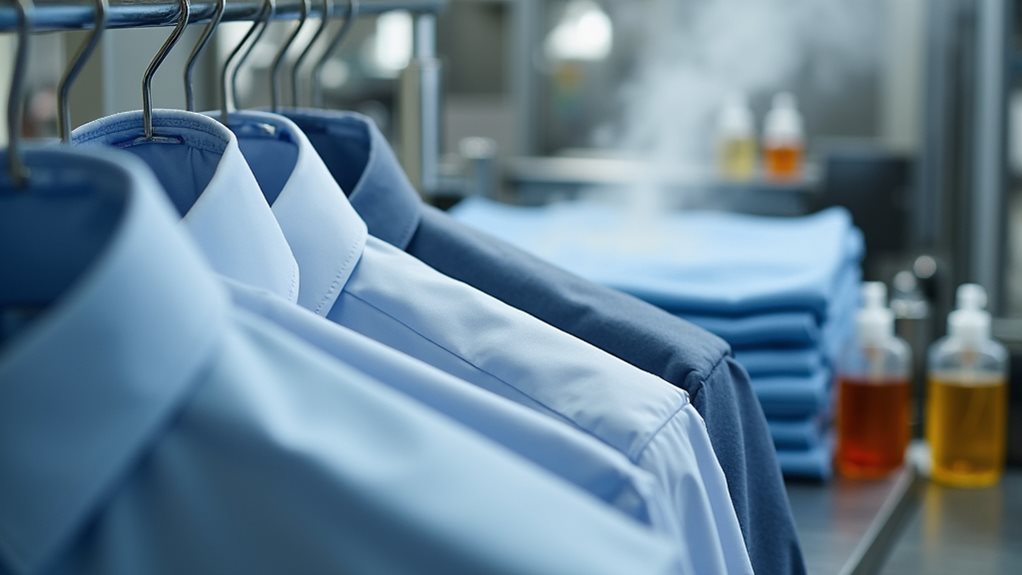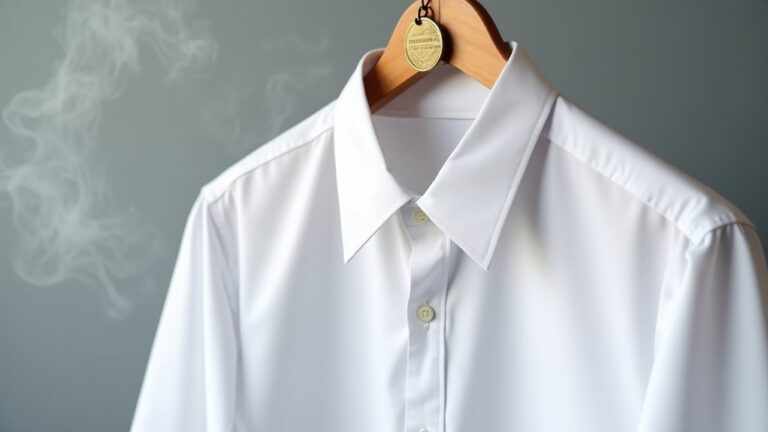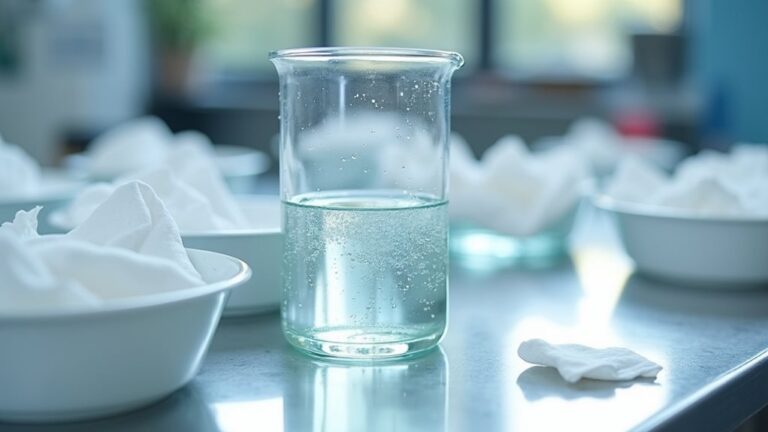When you drop off clothes at the dry cleaner, they’re tagged with unique IDs, then inspected for stains and damage before receiving targeted pre-treatments using specialized solvents for different stain types. Your garments get submerged in chemical solvents like perchloroethylene for 8-15 minutes, with machines recovering an impressive 99.99% of solvents through distillation for reuse. After post-cleaning stain checks and quality control, they’re professionally pressed, steamed, and packaged—though there’s much more happening behind those swinging doors.
Garment Inspection and Tagging
First things first, every single garment that enters a dry cleaning facility gets its own special ID tag, kind of like a passport that’ll follow it through its entire cleaning process.
During garment inspection, experienced cleaners become fabric detectives, carefully examining each piece for stains, damage, and forgotten treasures hiding in pockets—you’d be amazed what people leave behind! 😅
Professional dry cleaners are like fabric detectives, uncovering hidden stains, pocket surprises, and garment secrets during every inspection.
This tagging system guarantees your favorite blazer doesn’t accidentally become someone else’s wardrobe addition. Inspectors pay special attention to missing buttons, tears, or stubborn spots that need pre-treatment before the actual cleaning process begins.
Think of it as a personalized health check-up for your clothes, where every imperfection gets noted and addressed, making sure your garments receive the exact care they deserve.
During this inspection phase, cleaners also identify delicate fabrics like silk and wool that require special handling to prevent damage during the cleaning process.
Stain Pre-treatment and Pre-spotting
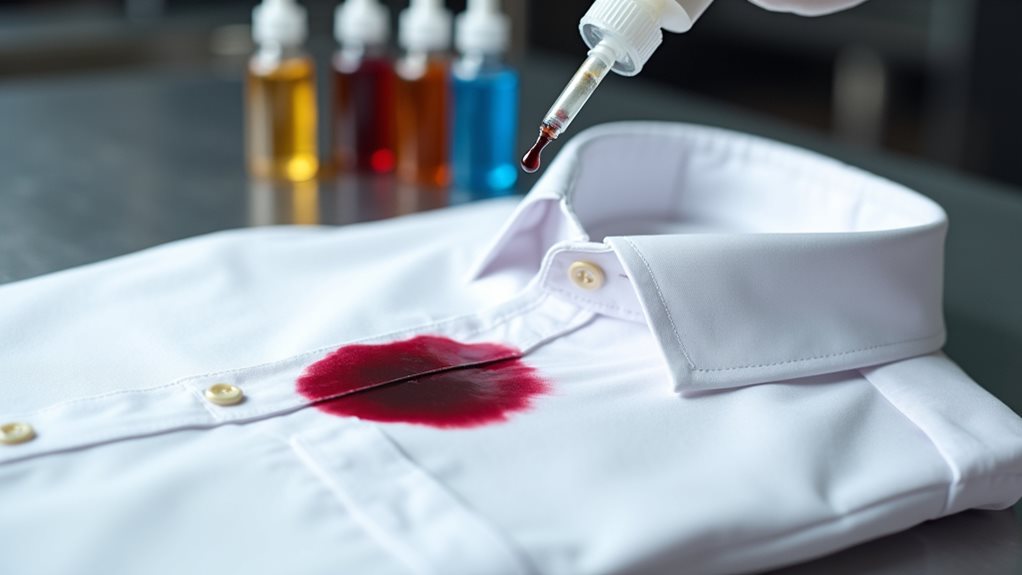
Once your garments have been tagged and thoroughly inspected, the real detective work begins with stain pre-treatment, where experienced cleaners fundamentally become stain whisperers, carefully studying each spot’s personality before choosing the perfect chemical matchmaker.
This pre-spotting process transforms stubborn stains from mysterious adversaries into manageable challenges, dramatically improving your overall cleaning outcome.
Different cleaning solvents target specific stain families:
- Oil-based stains (makeup, grease) require petroleum-based solvents
- Water-based stains (coffee, wine) need aqueous solutions
- Protein stains (blood, sweat) demand enzyme-based treatments
- Combination stains require multiple pre-treatment approaches
This vital step happens immediately after garment inspection, guaranteeing each stain receives personalized attention before the main cleaning cycle begins.
Without proper stain pre-treatment, even the most advanced dry cleaning equipment can’t assure complete removal.
Success in removing stains depends on several critical factors including the age of stains, fabric type, and the specific nature of the staining substance.
Machine Cleaning With Chemical Solvents
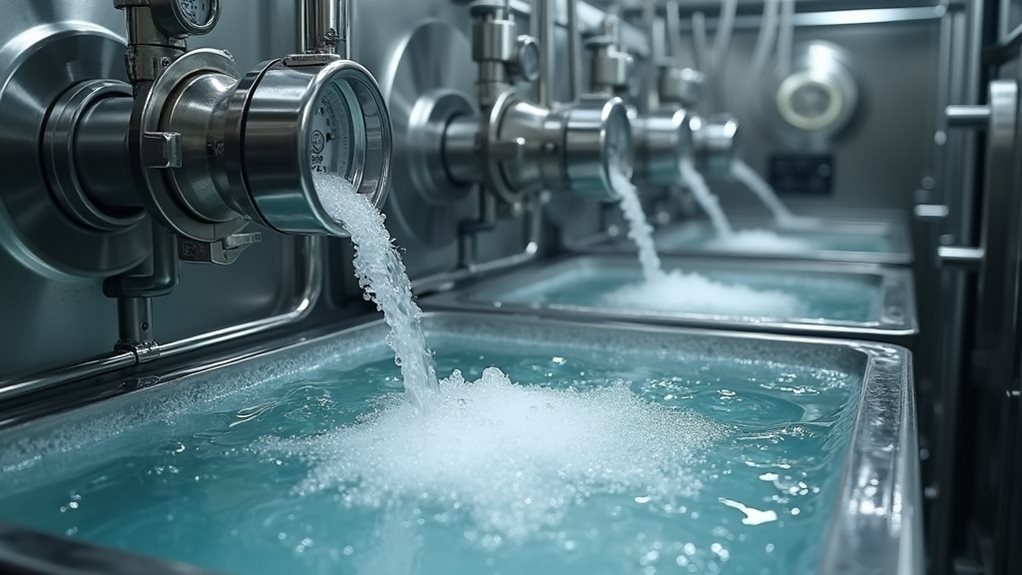
After your garments receive their personalized pre-treatment attention, they’re ready for the main event – a luxurious bath in specialized chemical solvents that work like magic on even the most stubborn stains.
The machine cleaning process submerges your clothes in perchloroethylene, a powerful solvent that lifts dirt without damaging delicate fabrics like your grandmother’s silk blouse. For 8-15 minutes, gentle agitation helps dislodge embedded grime while the chemical solvents work at a comfortable 30°C temperature – think of it as a warm, therapeutic spa treatment for your wardrobe! 😊
The genius part? Nearly 99.99% solvent recovery means these chemical warriors get recycled for future cleaning battles, making this process surprisingly eco-friendly while guaranteeing your garments emerge pristine and ready to impress. After washing, the extraction stage uses high-speed spinning to remove the solvent from your clothes, followed by heated air circulation that completes the drying process.
Solvent Recovery and Recycling
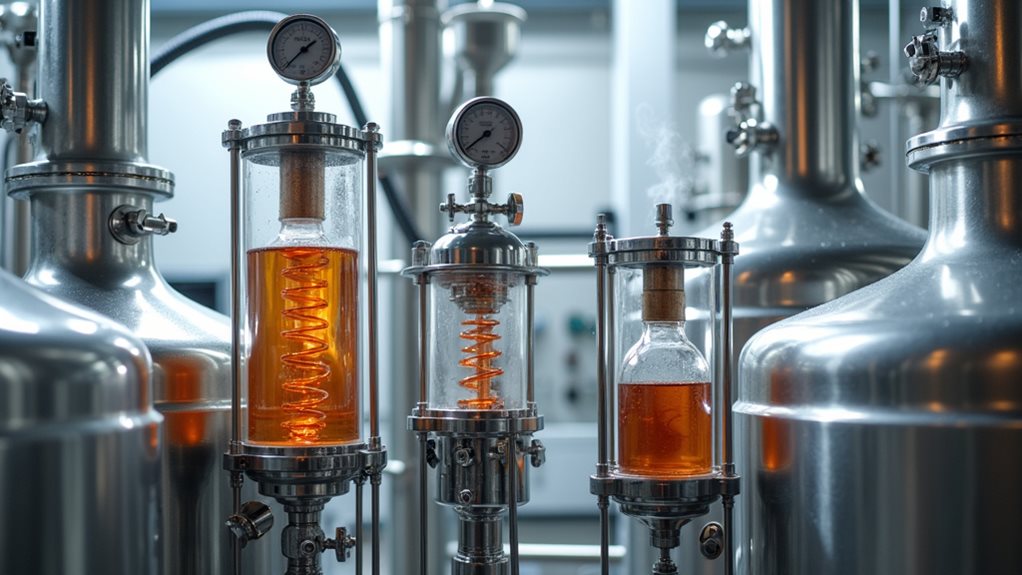
Behind every sparkling clean garment lies an impressive feat of engineering that would make any environmentalist smile – the solvent recovery and recycling system that transforms what could be wasteful into something remarkably sustainable.
Your clothes undergo cleaning in advanced dry cleaning machines that capture approximately 99.99% of solvents through closed-loop systems, preventing harmful chemicals from escaping into our environment.
Here’s how these recycling practices work:
- Solvent extraction occurs during the cleaning cycle
- Distillation purifies the recovered solvent for reuse
- Continuous monitoring guarantees compliance with environmental safety standards
- Regular maintenance keeps systems running efficiently
This incredible solvent recovery process dramatically reduces environmental impact while slashing operational costs for cleaners, proving that smart engineering can benefit both your wardrobe and our planet! 🌍
The distillation process is particularly effective with perchloroethylene (PERC), the most commonly used solvent in the industry, allowing cleaners to reuse the same solvent hundreds of times while maintaining its excellent cleaning power.
Post-spotting and Additional Stain Removal
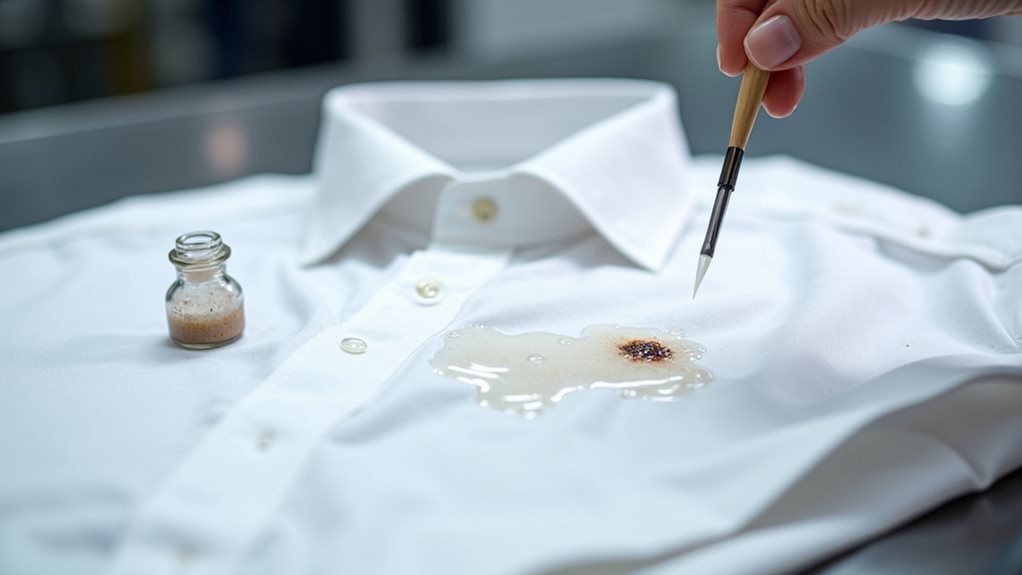
After your garments emerge from the solvent bath, you’ll need to become a detective of sorts, carefully examining each piece for those sneaky stains that somehow survived the initial cleaning process.
This final stain assessment requires patience and a keen eye, because trust me, I’ve learned the hard way that rushing through this step means disappointed customers and garments that come back looking worse than when they arrived 😅.
You’ll then apply specialized treatment methods customized to each stubborn spot, followed by a thorough quality control inspection that guarantees every garment meets the high standards your reputation depends on.
Once the post-spotting is complete, the garments move to the drying phase where any remaining chemical solvent is removed through controlled heat and air circulation before final pressing.
Final Stain Assessment
Precision becomes your dry cleaner’s best friend during the final stain assessment, a critical moment when they’re examining your garment with the focused intensity of a detective solving their most important case.
After the cleaning cycle wraps up, this post-spotting inspection process reveals whether those stubborn stains decided to stick around for an encore performance.
Your cleaner’s trained eyes scan every inch, searching for remnants that survived the initial treatment. When they spot lingering stains, they’ll deploy specialized stain removal agents customized to your fabric’s needs:
- Steam application for heat-sensitive stains
- Targeted chemical treatments for protein-based spots
- Gentle mechanical action for delicate fabrics
- Additional solvent exposure for oil-based residues
This meticulous quality check guarantees your garment emerges flawless before pressing begins. However, some stains may prove challenging to remove completely, particularly water-based stains like fruit juices or wine that don’t respond as well to the chemical solvents used in dry cleaning.
Specialized Treatment Methods
When your cleaner discovers those detective-worthy stains that laughed in the face of the initial cleaning cycle, they roll up their sleeves and reach for their arsenal of specialized weapons—think of it as the superhero moment where the real magic happens.
They’ll analyze whether you’re dealing with oil-based stains (hello, salad dressing mishaps) or water-based stains (coffee, anyone?), then select specialized products accordingly.
The post-spotting process involves targeted stain removal techniques, sometimes applying heat or chemical solvents that’d make a chemistry teacher proud.
Your cleaner’s expertise shines during fabric treatment, especially with delicate materials like silk or cashmere, guaranteeing quality standards while protecting your investment from damage—because nobody wants a clean but ruined garment! 🧪
The success of stain removal also depends on factors like how long the stain has been present and whether any previous treatment attempts have set the stain permanently.
Quality Control Inspection
Once the specialized treatment wraps up, your garment enters what I like to call the “final exam phase”—a meticulous quality control inspection that separates good dry cleaners from truly exceptional ones.
During this post-spotting phase, experienced technicians examine every inch of your clothing, hunting for stubborn stains that might’ve survived the initial cleaning process.
Here’s what happens during this vital quality control inspection:
- Thorough visual examination for remaining spots or discoloration
- Specialized stain removal using targeted solutions for persistent marks
- Overall cleanliness assessment checking fabric texture and appearance
- Final odor check confirming no residual solvent smells linger
This detailed inspection directly impacts customer satisfaction—it’s the difference between getting back a “clean enough” garment versus one that looks professionally pristine and ready for your most important occasions.
After passing inspection, garments proceed to pressing and steaming to restore their original shape and appearance before final packaging and return to customers.
Pressing and Steam Finishing
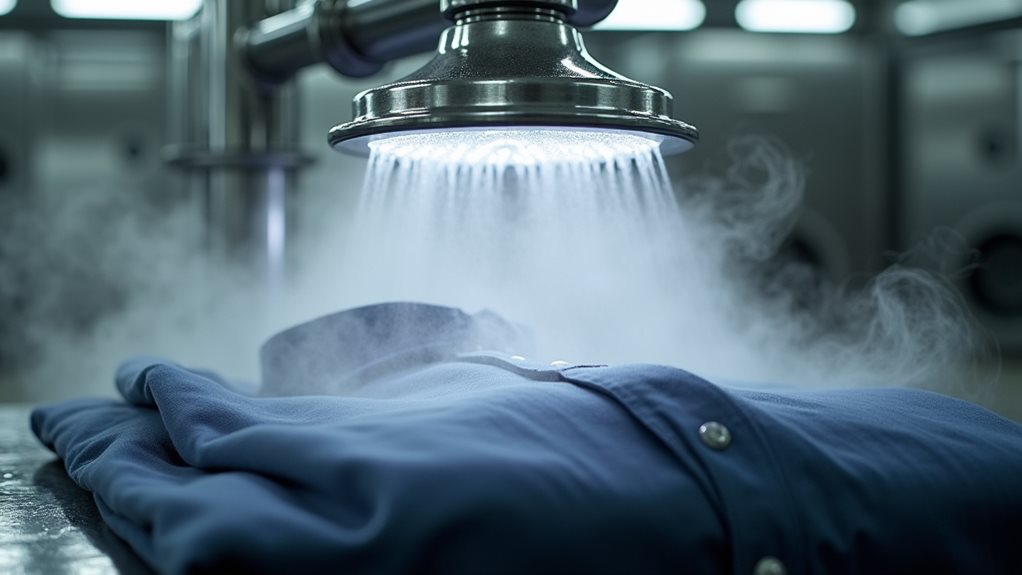
Once your garments emerge from the post-spotting phase, they’re ready for what I consider the most satisfying part of the entire process—pressing and steam finishing, where you’ll witness wrinkled, lifeless fabric transform into crisp, professional-looking clothing through careful steam heat application.
You’ll need to master specific wrinkle removal techniques that go beyond simply running a hot iron over everything, because different fabrics require different approaches, temperatures, and timing to avoid that dreaded shiny look I learned about the hard way on my favorite wool blazer 😅.
The real magic happens during garment shape restoration, where skilled pressing brings back those sharp collar edges, perfectly aligned seams, and that structured silhouette that makes clothes look like they just came from an expensive boutique.
This professional pressing service is one of the key advantages that sets dry cleaning apart from traditional home washing, ensuring your delicate fabrics maintain their original structure and appearance.
Steam Heat Application
After your garments emerge from their solvent bath looking clean but wrinkled like a deflated balloon, the magic of steam heat application transforms them back into crisp, professional-looking pieces that you’d actually want to wear out of the house.
The steam finishing process works by relaxing fabric fibers through controlled heat and moisture, gently coaxing your garment’s shape back to perfection without causing fabric damage to delicate materials like silk or wool.
Modern dry cleaning machines make this cleaning process incredibly efficient by incorporating these four key elements:
- Controlled temperature regulation for sensitive fabrics
- Precise moisture distribution to eliminate wrinkles
- Automated timing to prevent overheating
- Specialized attachments for different garment types
This sophisticated approach guarantees your clothes emerge looking professionally pressed, ready to make you feel confident and polished. The pressing and steaming process restores the garment’s original appearance, which is especially important for structured garments that require maintaining their intended shape and form.
Wrinkle Removal Techniques
While steam application works wonders for relaxing those stubborn fabric fibers, the real artistry happens when your dry cleaner combines this technique with precise pressing methods that’ll make your favorite blazer look like it just stepped off a magazine cover.
Professional dry cleaners wield specialized pressing equipment like master craftsmen, adjusting temperature and pressure settings for each fabric type—because your silk blouse obviously can’t handle the same heat as your wool trousers!
The wrinkle removal process involves careful steam finishing followed by strategic pressing, guaranteeing delicate fabrics receive gentle treatment while achieving that crisp, polished appearance you’re after.
This combination transforms wrinkled garments into professionally finished pieces, proving that proper technique makes all the difference between “acceptable” and absolutely stunning results.
Garment Shape Restoration
When your freshly cleaned garments emerge from the solvent bath, they’re like a sculpture that’s been carved but not yet polished—technically clean but missing that crisp, professional finish that separates amateur results from true craftsmanship.
This is where pressing and steam finishing transform your garment from “meh” to magnificent, restoring its original shape while banishing those stubborn wrinkles that somehow survive the cleaning process.
Professional techniques involve four essential steps:
- Heated pressing with specialized irons that apply controlled pressure to fabric
- Steam finishing using moist heat to relax fibers naturally
- Targeted tools like clappers and sleeve boards for delicate areas
- Careful attention to collars, cuffs, and seams without damaging fabric
This meticulous process doesn’t just restore your garment’s aesthetic appeal—it actually prolongs its lifespan by maintaining structural integrity.
Final Quality Check and Repairs

Quality becomes everything in those final moments before your freshly cleaned garment makes its way back to your closet, and I’ve learned that this last checkpoint can make or break your entire dry cleaning experience.
During this final quality check, inspectors scrutinize every inch for remaining stains that might’ve survived the initial cleaning, sending stubborn spots back to the post-spotting phase for additional treatment.
Every garment gets a microscopic inspection to catch sneaky stains that thought they could slip past our eagle-eyed quality team.
They’ll examine loose buttons, broken zippers, and minor tears with detective-like precision, because honestly, returning a clean shirt with a dangling button feels like serving a gourmet meal on a paper plate 😅.
When repairs are needed, skilled technicians step in to restore your garment’s functionality and appearance, guaranteeing customer satisfaction through meticulous attention to detail.
Packaging and Preparation for Return
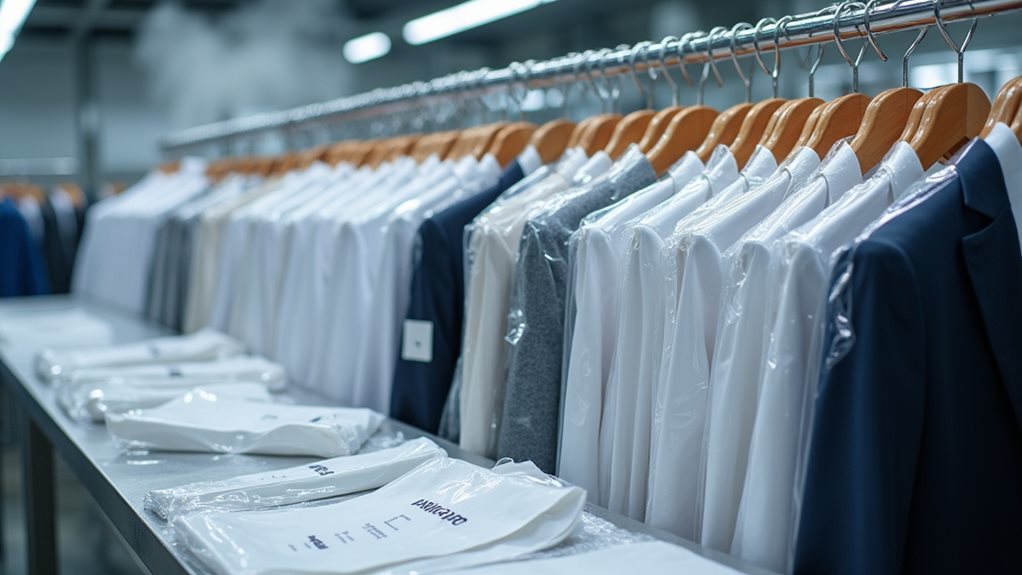
Precision takes center stage as your freshly cleaned garments shift from the quality check station to their final packaging phase. I’ve watched countless times as this seemingly simple step transforms into an art form that speaks volumes about a dry cleaner’s commitment to excellence.
Your cleaned clothes undergo a methodical preparation process that guarantees they’ll arrive in perfect condition:
- Identification tagging – Each piece receives proper labeling for accurate customer matching
- Protective covering – Plastic or paper shields guard against dust and transportation damage
- Proper arrangement – Items are folded or hung based on fabric requirements
- Organized storage – Garments are systematically arranged for efficient retrieval and delivery
This packaging ritual transforms your freshly cleaned items into professionally presented garments ready for pickup or delivery to customers.

